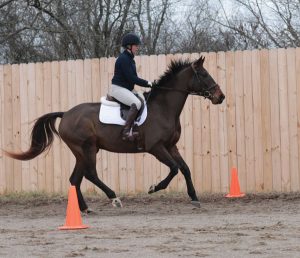
Getting the right counts in a line can often seem like the ultimate test on a jumping course. Lines are two or more jumps set apart by a measured distance, and are meant to be ridden in a specific number of consistent, even strides. Any deviation is usually considered a fault in hunter and equitation competition. If you and your horse struggle with lines, here are some tips to help solve the problem for the perfect jumping line, courtesy of hunter and equitation trainer Susan Smith of Norco, Calif.
Meet the Trainer |
Know Your Horse’s Canter
First, you need to analyze your horse’s canter stride.
“Most people canter around their arena on a 10- to 11-foot stride without realizing it,” says Smith. At shows, the measured distance in a line is based on a standard 12-foot stride.
“If you’re used to cantering on a 10-foot stride, and setting lines at home according to your comfort zone, you’ll get to a show and be suddenly surprised,” she says.

Smith suggests cantering over poles on the ground that are set at a distance mimicking a simple line. Then you can gauge whether you need to lengthen or collect your horse’s stride for an actual course.
“I set two ground poles about 66 feet apart, which should ride in five strides,” says Smith, who notes that the distance is about 6 feet shorter than the traditional measurement because they aren’t actual jumps.
“They’re just poles, so the horse’s arc won’t be much more than just a canter stride. But this will still give you a clear idea of your horse’s normal canter stride.”
If you discover that your horse runs out of room between the poles, daring to leave out an entire stride, use your aids to collect him. Open your hip angle, settle a little deeper into the saddle and steady slightly with your hands.
Yet if you’re like most riders and realize your horse wants to add an extra stride (or two) between the poles, you’ll need to lengthen his stride. Close your hip angle and soften your contact with his mouth. With every stride, press your horse forward with your leg.
“But be careful,” says Smith. “You want to encourage your horse to open up his stride, not merely go faster. There’s a definite difference.”

Ride the Exercise
Smith has a favorite exercise for riders who seem to lose their way inside a line of jumps.
“As an example, let’s take a typical six-stride line,” she says. “Most riders jump in, get to the third or fourth stride, and then suddenly realize they’re never going to make it out in six strides. They do one of two things. They either grab with their leg and chase their horse through the line, which usually results in an ugly chip [short, awkward stride] at the end. Or they grab onto their horse’s mouth out of fear, holding their horse back, which ultimately adds extra strides in the line.”
To help riders learn to judge where they are in a line, Smith sets two jumps (about 2’9″ to 3′ high) 80 feet apart. This means the line will ride six strides from the first jump to the second jump.
Midway through the line (at 40 feet), she places a pair of cones about 10 feet apart as visual markers. The goal is to get your horse’s front end between the cones on the third stride, which is the halfway point as you ride through the line. Then you know you have another three strides before your horse leaves the ground to jump out of the line.
“If your horse is several feet behind the cones on the third stride, then you have to move up for the last few strides to make the correct count,” says Smith. “If you’re several feet past the cones, then you must collect your horse and steady. Ultimately, it’s a way for you to develop an eye or a feel for when you’re spot-on to get six even strides in a six-stride line.”
Tips for a Straight Track

Smith warns against any zigging or zagging within a line.
“If you deviate from a straight track in a line, you’re adding footage. You’ve made the distance between the jumps even longer, and you’ll be forced to add a stride.”
To practice riding a straight track, use ground poles to create an alley or lane between the jumps. Lay pairs of poles perpendicular to the jumps, about 6 feet apart. Include them before the first jump of a line, through the middle and just after the last jump, too. They’ll help you focus on staying straight.
This article on the perfect jumping line appeared in the March 2020 issue of Horse Illustrated magazine. Click here to subscribe!





